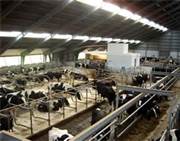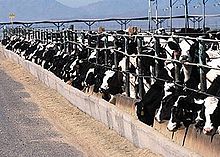Beef cows
Many beef cattle are born and/or live on the range, foraging and fending for themselves, for months or even years. They are not adequately protected against inclement weather, and they may die of dehydration or freeze to death. Injured, ill, or otherwise ailing animals do not receive necessary veterinary attention. One common malady afflicting beef cattle is called “cancer eye”. Left untreated, the cancer eats away at the animal’s eye and face, eventually producing a crater in the side of the animal’s head. Accustomed to roaming unimpeded and unconstrained, range cattle are frightened and confused when humans come to round them up. Injuries often result as terrified animals are corralled and packed onto cattle trucks. Many will experience additional transportation and handling stress at stock yards and auctions where they are goaded through a series of walkways and holding pens and sold to the highest bidder. From the auction, older cattle may be taken directly to slaughter, or they may be takento a feedlot. Younger animals, and breeding age cows, may go back to the range. Ranchers still identify cattle the same way they have since pioneer days, with hot iron brands. Needless to say, this practice is extremely traumatic and painful, and the animals bellow loudly as ranchers’ brands are burned into their skin. Beef cattle are also subjected to waddling, another type of identification marking. This painful procedure entails cutting chunks out of the hide which hangs under the animals’ necks. Waddling marks are supposed to be large enough so that ranchers can identify their cattle from a distance. Most beef cattle spend the last few months of their lives at feedlots, crowded by the thousand into dusty, manure-laden holding pens. The air is thick with harmful bacteria and particulate matter, and the animals are at a constant risk for respiratory disease. Feedlot cattle are routinely implanted with growth promoting hormones, and they are fed unnaturally rich diets designed to fatten them quickly and profitably. Because cattle are biologically suited to eat a grass-based, high fiber diet, their concentrated feedlot rations contribute to metabolic disorders. Cattle may be transported several times during their lifetimes, and they may travel hundreds or even thousands of miles during a single trip. Long journeys are very stressful and contribute to disease. Young cattle are commonly taken to areas with cheap grazing land, to take advantage of this inexpensive feed source. Upon reaching maturity, they are trucked to a feedlot to be fattened and readied for slaughter. Eventually, all of them will end up at the slaughterhouse. At a standard beef slaughterhouse, 250 cattle are killed every hour.
Once animals get to the slaughterhouse animals,such as cows and pigs are led to the killing floor,where they are stunned by electiric shock,shackled,hoisted upside down,kicking and struggling,and butered.delivering a potent shock is often difficult or too much trouble for the slaughterhouse workers and the result is that some animals regain conciousness while hanging and waiting for slaughter or during the slaughtering process itself.Eventually, the animals will be “stuck” in the throat with a knife, and blood will gush from their bodies whether or not they are unconscious.At slaughterhouses that produce kosher or balal meat,the animals are NOT stunned before having their carotid arties severed.
All animals have the right to live.
Please visit – http://friendsaganistcrueltytoanimals.weebly.com/factory-farming.html
THANK YOU.



